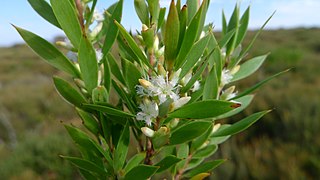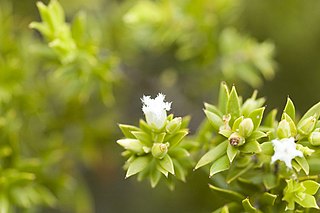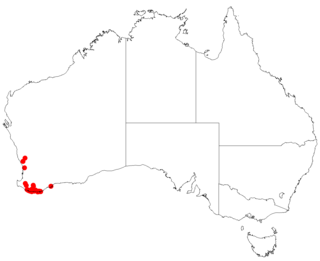
Leucopogon juniperinus, commonly known as prickly beard-heath, is a species of flowering plant in the heath family Ericaceae and is endemic to south-eastern continental Australia. It is an erect, densely-branched shrub with oblong to more or less egg-shaped leaves with the narrower end towards the base, and white, tube-shaped flowers arranged singly in upper leaf axils.

Leucopogon ericoides, commonly known as the pink beard-heath, is a species of flowering plant in the heath family Ericaceae and is endemic to south-eastern Australia. It is a slender shrub with oblong leaves, and white to pinkish, tube-shaped flowers.

Leucopogon esquamatus, commonly known as the swamp beard-heath, is a species of flowering plant in the heath family Ericaceae and is endemic to south-eastern Australia. It is a slender shrub with mainly elliptic leaves, and short-lived white, tube-shaped flowers arranged singly or in pairs in upper leaf axils.

Leucopogon pendulus is a species of flowering plant in the heath family Ericaceae and is endemic to the south-west of Western Australia. It is an erect, straggling shrub with oblong leaves and white, tube-shaped flowers that are bearded inside.

Leucopogon gracilis is a species of flowering plant in the heath family Ericaceae and is endemic to the south of Western Australia. It is a spindly shrub with wiry branchlets, linear to lance-shaped leaves, and dense spikes of white or pinkish flowers.

Leucopogon muticus, commonly knwon as blunt beard-heath, is a species of flowering plant in the heath family Ericaceae and is endemic to eastern Australia. It is an erect, straggling shrub with egg-shaped leaves with the narrower end towards the base, and small numbers of white, tube-shaped flowers that are densely bearded inside.

Leucopogon australis, commonly known as spiked beard-heath, is a species of flowering plant in the heath family Ericaceae and is endemic to southern Australia. It is an erect, aromatic shrub with narrowly egg-shaped to narrowly elliptic leaves, and white flowers arranged in spikes near the ends of branchlets.

Leucopogon biflorus is a species of flowering plant in the heath family Ericaceae and is endemic to eastern Australia. It is an erect to spreading shrub with hairy branchlets, oblong leaves and small white flowers.

Leucopogon collinus, commonly known as fringed beard-heath, is a species of flowering plant in the heath family Ericaceae and is endemic to south-eastern Australia. It is a slender, erect or spreading shrub with narrowly lance-shaped leaves, and white, tube-shaped, bearded flowers.

Leucopogon assimilis is a species of flowering plant in the family Ericaceae and is endemic to the south of Western Australia. It is an erect, slender shrub with linear or lance-shaped leaves and pink to white, tube-shaped flowers.

Leucopogon carinatus is a species of flowering plant in the heath family Ericaceae and is endemic to the south-west of Western Australia. It is an erect or spreading shrub that typically grows to a height of 0.15–1.2 m and has many branches. Its leaves are oval to lance-shaped or almost linear and mostly 4–6.5 mm (0.16–0.26 in) long. The flowers are borne on short, dense spikes on the ends of branches or in upper leaf axils with small bracts and bracteoles about half as long as the sepals. The sepals are about 5.3 mm (0.21 in) long, rigid and pointed. The petals are white and 3–4 mm (0.12–0.16 in) long, the petal lobes longer than the petal tube. Flowering mainly occurs from July to December.

Leucopogon cucullatus is a flowering plant in the family Ericaceae and is endemic to the south-west of Western Australia. It is an erect shrub that typically grows to a height of 0.3–1 m. The leaves are crowded, egg-shaped to more or less round, and 4.0–8.5 mm (0.16–0.33 in) long. The flowers are arranged in small groups in short, dense spikes on the ends of branches or in upper leaf axils, with leaf-like bracts and bracteoles about 4 mm (0.16 in) long at the base. The sepals are 3–4 mm (0.12–0.16 in) long and the petals almost 6 mm (0.24 in) long, the lobes longer than the petal tube. Flowering occurs from July to January.

Leucopogon deformis is a species of flowering plant in the heath family Ericaceae and is endemic to eastern coastal Australia. It is a bushy shrub with narrowly egg-shaped leaves, and white, tube-shaped flowers.

Leucopogon distans is a flowering plant in the family Ericaceae and is endemic to the south-west of Western Australia. It is an erect shrub that typically grows to a height of 0.2–1.2 m. The leaves are heart-shaped to egg-shaped or lance-shaped, 2–4.5 mm (0.079–0.177 in) long with the edges rolled under. The flowers are arranged in spikes on the ends of branches or in upper leaf axils, the flowers well-spaced from each other, with small bracts and broad bracteoles at the base. The sepals are about 4 mm (0.16 in) long, the petal tube about the same length as the sepals, the lobes about twice as long. Flowering occurs from July to February.

Leucopogon glabellus is a species of flowering plant in the family Ericaceae and is endemic to the south-west of Western Australia. It is an erect, glabrous shrub with slender branchlets, heart-shaped to lance-shaped leaves, and cylindrical spikes of white flowers.

Leucopogon interruptus is a species of flowering plant in the family Ericaceae and is endemic to the southwest of Western Australia. It is a spreading, glabrous shrub with oval to oblong leaves crowded at the ends of branches, and many small, white, tube-shaped flowers that are bearded inside.

Leucopogon leptospermoides is a species of flowering plant in the heath family Ericaceae and is endemic to eastern Australia. It is an erect, bushy shrub with elliptic to lance-shaped or oblong leaves, and white, tube-shaped flowers usually arranged singly in upper leaf axils.

Leucopogon polystachyus is a species of flowering plant in the heath family Ericaceae and is endemic to the south-west of Western Australia. It is a slender, erect, usually glabrous shrub that typically grows to a height of 0.4–2 m. Its leaves are linear to lance-shaped, 8.5–17 mm (0.33–0.67 in) long with a rigid, sharply-pointed tip on the end. The flowers are borne on the ends of branches or in leaf axils in short, dense spikes with small, egg-shaped bracts and bracteoles about half as long as the sepals. The sepals are about 3.2 mm (0.13 in) long and often pale pink, and the petals are white, about 4 mm (0.16 in) long and joined at the base, forming a tube, the petal lobes longer than the petal tube.

Leucopogon reflexus, commonly known as heart-leaf beard-heath, is a species of flowering plant in the heath family Ericaceae and is endemic to the south-west of Western Australia. It is an erect shrub with small, usually downturned leaves and short, dense spikes of tube-shaped, white flowers.

Leucopogon rotundifolius is a species of flowering plant in the heath family Ericaceae and is endemic to the south of Western Australia. It is an erect, bushy shrub with round or egg-shaped leaves, the narrower end towards the base, and white, tube-shaped flowers arranged in leaf axils in groups of 2 or 3.

























